YAMAHA XCITY 250 2012 User Guide
Manufacturer: YAMAHA, Model Year: 2012, Model line: XCITY 250, Model: YAMAHA XCITY 250 2012Pages: 82, PDF Size: 1.89 MB
Page 11 of 82

SAFETY INFORMATION
1-4
1 Genuine Yamaha Accessories
Choosing accessories for your vehicle
is an important decision. Genuine
Yamaha accessories, which are avail-
able only from a Yamaha dealer, have
been designed, tested, and approved
by Yamaha for use on your vehicle.
Many companies with no connection to
Yamaha manufacture parts and acces-
sories or offer other modifications for
Yamaha vehicles. Yamaha is not in a
position to test the products that these
aftermarket companies produce.
Therefore, Yamaha can neither en-
dorse nor recommend the use of ac-
cessories not sold by Yamaha or
modifications not specifically recom-
mended by Yamaha, even if sold and
installed by a Yamaha dealer.
Aftermarket Parts, Accessories, and
Modifications
While you may find aftermarket prod-
ucts similar in design and quality to
genuine Yamaha accessories, recog-
nize that some aftermarket accessories
or modifications are not suitable be-
cause of potential safety hazards to you
or others. Installing aftermarket prod-ucts or having other modifications per-
formed to your vehicle that change any
of the vehicle’s design or operation
characteristics can put you and others
at greater risk of serious injury or death.
You are responsible for injuries related
to changes in the vehicle.
Keep the following guidelines in mind,
as well as those provided under “Load-
ing” when mounting accessories.
●
Never install accessories or carry
cargo that would impair the perfor-
mance of your scooter. Carefully
inspect the accessory before using
it to make sure that it does not in
any way reduce ground clearance
or cornering clearance, limit sus-
pension travel, steering travel or
control operation, or obscure lights
or reflectors.
Accessories fitted to the handle-
bar or the front fork area can
create instability due to improper
weight distribution or aerody-
namic changes. If accessories
are added to the handlebar or
front fork area, they must be as
lightweight as possible and
should be kept to a minimum. Bulky or large accessories may
seriously affect the stability of
the scooter due to aerodynamic
effects. Wind may attempt to lift
the scooter, or the scooter may
become unstable in cross
winds. These accessories may
also cause instability when
passing or being passed by
large vehicles.
Certain accessories can dis-
place the operator from his or
her normal riding position. This
improper position limits the free-
dom of movement of the opera-
tor and may limit control ability,
therefore, such accessories are
not recommended.
●
Use caution when adding electri-
cal accessories. If electrical acces-
sories exceed the capacity of the
scooter’s electrical system, an
electric failure could result, which
could cause a dangerous loss of
lights or engine power.
U5B2E4E0.book Page 4 Friday, June 1, 2012 9:06 AM
Page 12 of 82

SAFETY INFORMATION
1-5
1Aftermarket Tires and Rims
The tires and rims that came with your
scooter were designed to match the
performance capabilities and to provide
the best combination of handling, brak-
ing, and comfort. Other tires, rims, siz-
es, and combinations may not be
appropriate. Refer to page 6-15 for tire
specifications and more information on
replacing your tires.
Transporting the Scooter
Be sure to observe following instruc-
tions before transporting the scooter in
another vehicle.
●
Remove all loose items from the
scooter.
●
Point the front wheel straight
ahead on the trailer or in the truck
bed, and choke it in a rail to pre-
vent movement.
●
Secure the scooter with tie-downs
or suitable straps that are attached
to solid parts of the scooter, such
as the frame or upper front fork tri-
ple clamp (and not, for example, to
rubber-mounted handlebars or
turn signals, or parts that could
break). Choose the location for thestraps carefully so the straps will
not rub against painted surfaces
during transport.
●
The suspension should be com-
pressed somewhat by the tie-
downs, if possible, so that the
scooter will not bounce excessive-
ly during transport.
EAU10373
Further safe-riding points ●
Be sure to signal clearly when
making turns.
●
Braking can be extremely difficult
on a wet road. Avoid hard braking,
because the scooter could slide.
Apply the brakes slowly when
stopping on a wet surface.
●
Slow down as you approach a cor-
ner or turn. Once you have com-
pleted a turn, accelerate slowly.
●
Be careful when passing parked
cars. A driver might not see you
and open a door in your path.
●
Railroad crossings, streetcar rails,
iron plates on road construction
sites, and manhole covers be-
come extremely slippery when
wet. Slow down and cross them
with caution. Keep the scooter up-
right, otherwise it could slide out
from under you.
●
The brake pads could get wet
when you wash the scooter. After
washing the scooter, check the
brakes before riding.
U5B2E4E0.book Page 5 Friday, June 1, 2012 9:06 AM
Page 13 of 82

SAFETY INFORMATION
1-6
1
●
Always wear a helmet, gloves,
trousers (tapered around the cuff
and ankle so they do not flap), and
a bright colored jacket.
●
Do not carry too much luggage on
the scooter. An overloaded scoot-
er is unstable. Use a strong cord to
secure any luggage to the carrier
(if equipped). A loose load will af-
fect the stability of the scooter and
could divert your attention from the
road. (See page 1-3.)
U5B2E4E0.book Page 6 Friday, June 1, 2012 9:06 AM
Page 14 of 82
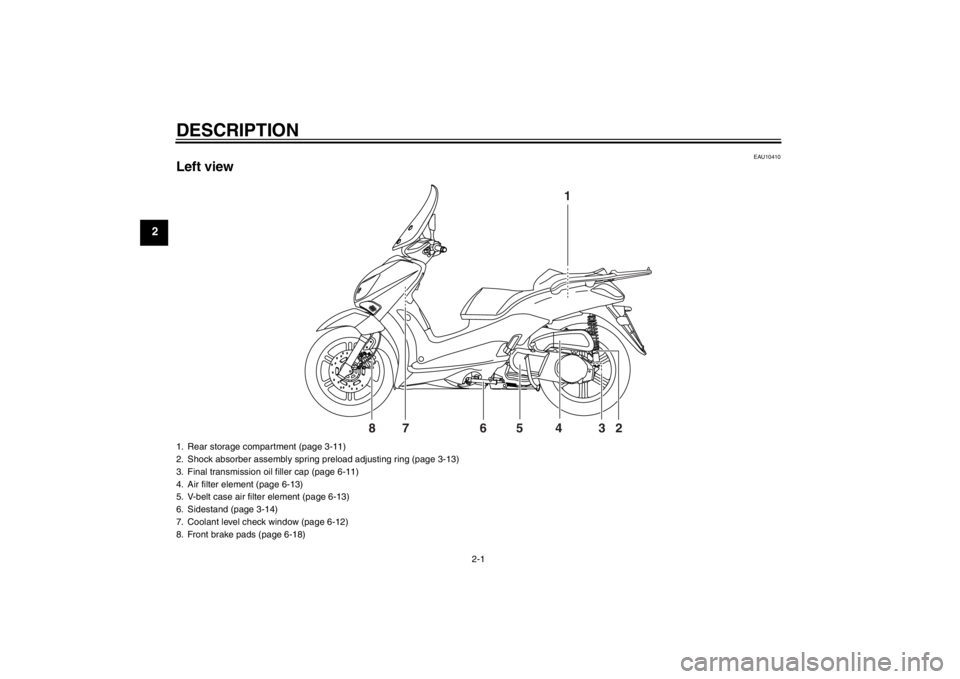
DESCRIPTION
2-1
2
EAU10410
Left view
1
2 3 4 5 76 8
1. Rear storage compartment (page 3-11)
2. Shock absorber assembly spring preload adjusting ring (page 3-13)
3. Final transmission oil filler cap (page 6-11)
4. Air filter element (page 6-13)
5. V-belt case air filter element (page 6-13)
6. Sidestand (page 3-14)
7. Coolant level check window (page 6-12)
8. Front brake pads (page 6-18)U5B2E4E0.book Page 1 Friday, June 1, 2012 9:06 AM
Page 15 of 82

DESCRIPTION
2-2
2
EAU10420
Right view
2 13 4
5 6 7 8
1. Grab bar (page 5-2)
2. Main fuse/fuse box (page 6-25)
3. Battery (page 6-23)
4. Coolant reservoir cap (page 6-12)
5. Fuel tank cap (page 3-7)
6. Engine oil filler cap (page 6-9)
7. Centerstand (page 6-21)
8. Rear brake pads (page 6-18)
U5B2E4E0.book Page 2 Friday, June 1, 2012 9:06 AM
Page 16 of 82
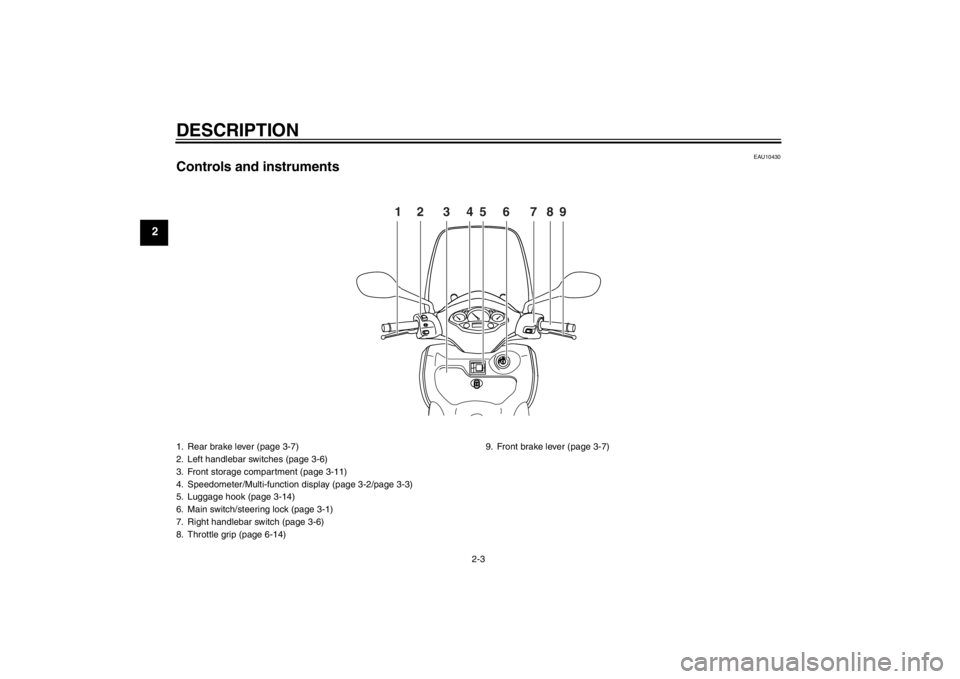
DESCRIPTION
2-3
2
EAU10430
Controls and instruments
PUSHOPEN
12 3456 789
1. Rear brake lever (page 3-7)
2. Left handlebar switches (page 3-6)
3. Front storage compartment (page 3-11)
4. Speedometer/Multi-function display (page 3-2/page 3-3)
5. Luggage hook (page 3-14)
6. Main switch/steering lock (page 3-1)
7. Right handlebar switch (page 3-6)
8. Throttle grip (page 6-14)9. Front brake lever (page 3-7)U5B2E4E0.book Page 3 Friday, June 1, 2012 9:06 AM
Page 17 of 82
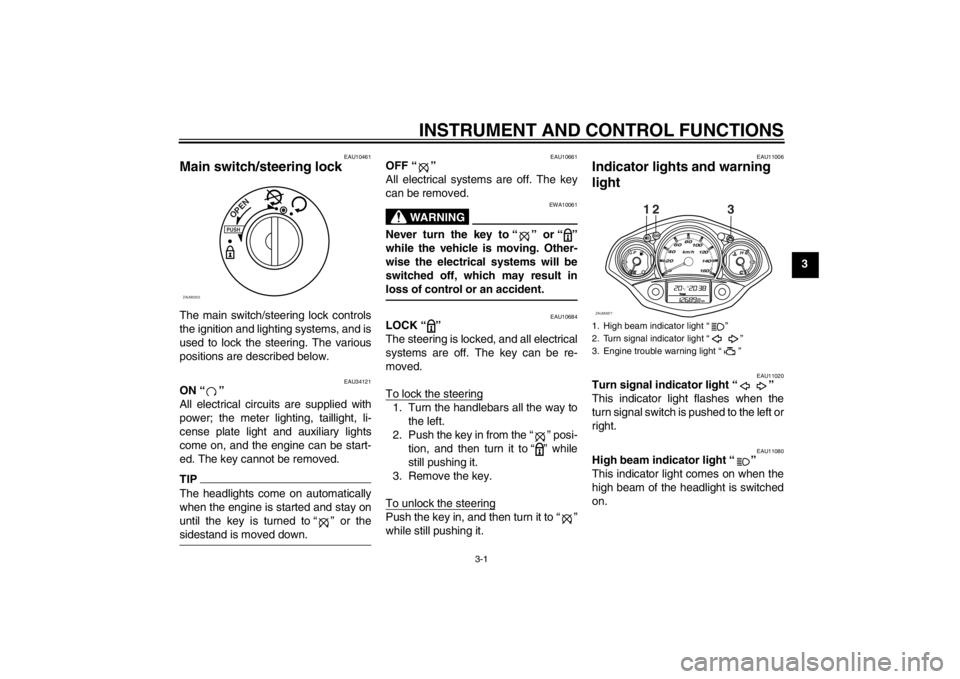
INSTRUMENT AND CONTROL FUNCTIONS
3-1
3
EAU10461
Main switch/steering lock The main switch/steering lock controls
the ignition and lighting systems, and is
used to lock the steering. The various
positions are described below.
EAU34121
ON “ ”
All electrical circuits are supplied with
power; the meter lighting, taillight, li-
cense plate light and auxiliary lights
come on, and the engine can be start-
ed. The key cannot be removed.TIPThe headlights come on automatically
when the engine is started and stay on
until the key is turned to “ ” or the
sidestand is moved down.
EAU10661
OFF “ ”
All electrical systems are off. The key
can be removed.
WARNING
EWA10061
Never turn the key to “ ” or “ ”
while the vehicle is moving. Other-
wise the electrical systems will be
switched off, which may result in
loss of control or an accident.
EAU10684
LOCK “ ”
The steering is locked, and all electrical
systems are off. The key can be re-
moved.
To lock the steering1. Turn the handlebars all the way to
the left.
2. Push the key in from the “ ” posi-
tion, and then turn it to “ ” while
still pushing it.
3. Remove the key.
To unlock the steeringPush the key in, and then turn it to “ ”
while still pushing it.
EAU11006
Indicator lights and warning
light
EAU11020
Turn signal indicator light “ ”
This indicator light flashes when the
turn signal switch is pushed to the left or
right.
EAU11080
High beam indicator light “ ”
This indicator light comes on when the
high beam of the headlight is switched
on.
PUSHOPEN
ZAUM0253
1. High beam indicator light ì î
2. Turn signal indicator light ì î
3. Engine trouble warning light ì î
12 3
ZAUM0877
U5B2E4E0.book Page 1 Friday, June 1, 2012 9:06 AM
Page 18 of 82
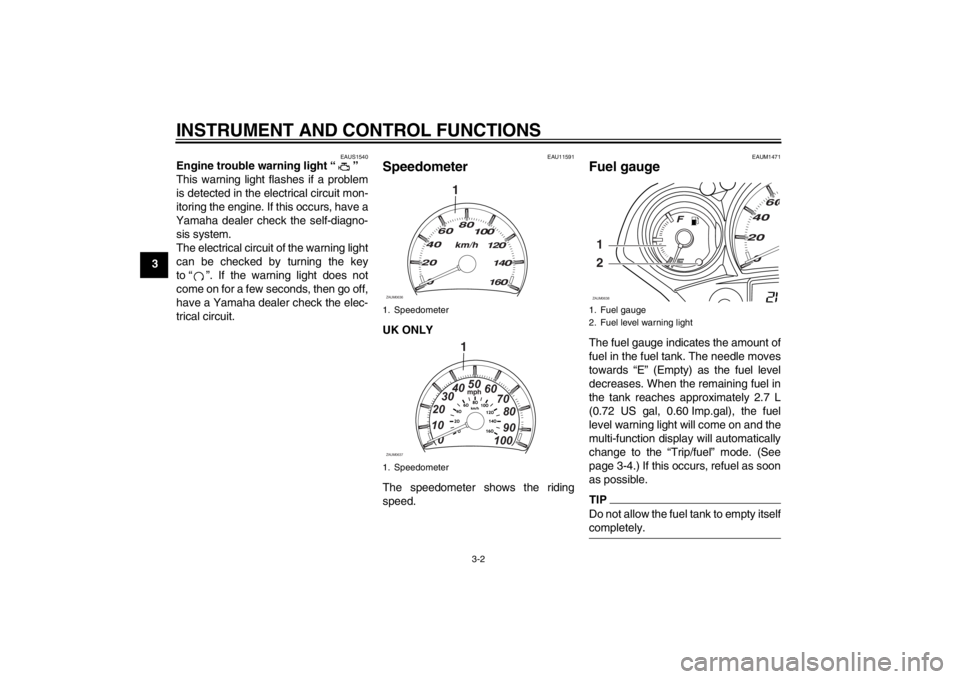
INSTRUMENT AND CONTROL FUNCTIONS
3-2
3
EAUS1540
Engine trouble warning light “ ”
This warning light flashes if a problem
is detected in the electrical circuit mon-
itoring the engine. If this occurs, have a
Yamaha dealer check the self-diagno-
sis system.
The electrical circuit of the warning light
can be checked by turning the key
to “ ”. If the warning light does not
come on for a few seconds, then go off,
have a Yamaha dealer check the elec-
trical circuit.
EAU11591
Speedometer UK ONLY
The speedometer shows the riding
speed.
EAUM1471
Fuel gauge The fuel gauge indicates the amount of
fuel in the fuel tank. The needle moves
towards “E” (Empty) as the fuel level
decreases. When the remaining fuel in
the tank reaches approximately 2.7 L
(0.72 US gal, 0.60 Imp.gal), the fuel
level warning light will come on and the
multi-function display will automatically
change to the “Trip/fuel” mode. (See
page 3-4.) If this occurs, refuel as soon
as possible.TIPDo not allow the fuel tank to empty itself
completely.
1. Speedometer
1. Speedometer
1
ZAUM0636
1mph
0 1020304050
60
70
80
90
100
ZAUM0637
1. Fuel gauge
2. Fuel level warning light1
2ZAUM0638
U5B2E4E0.book Page 2 Friday, June 1, 2012 9:06 AM
Page 19 of 82
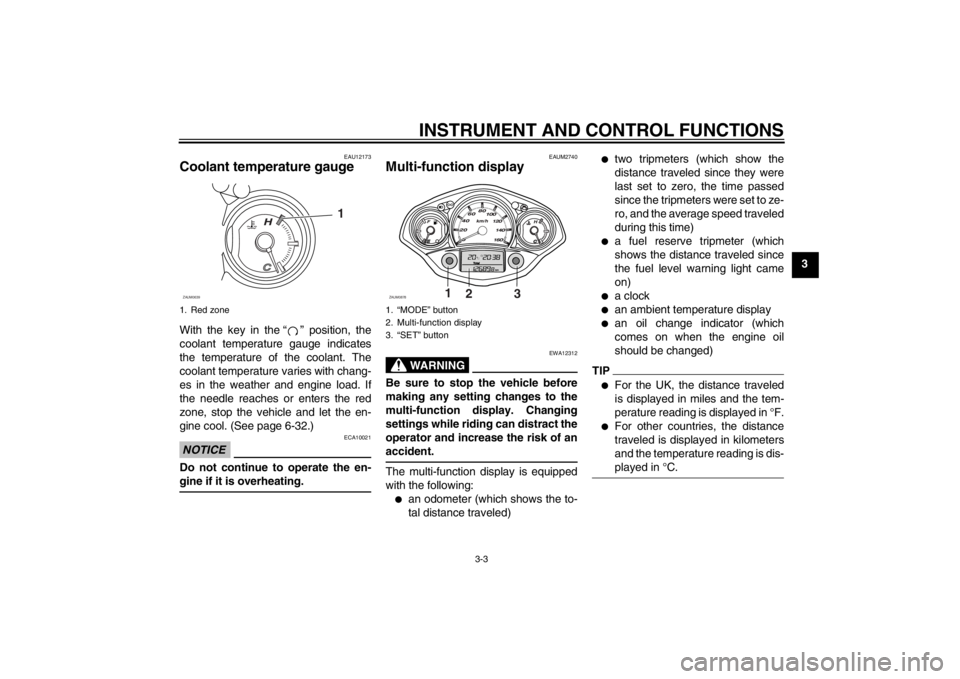
INSTRUMENT AND CONTROL FUNCTIONS
3-3
3
EAU12173
Coolant temperature gauge With the key in the “ ” position, the
coolant temperature gauge indicates
the temperature of the coolant. The
coolant temperature varies with chang-
es in the weather and engine load. If
the needle reaches or enters the red
zone, stop the vehicle and let the en-
gine cool. (See page 6-32.)NOTICE
ECA10021
Do not continue to operate the en-
gine if it is overheating.
EAUM2740
Multi-function display
WARNING
EWA12312
Be sure to stop the vehicle before
making any setting changes to the
multi-function display. Changing
settings while riding can distract the
operator and increase the risk of an
accident.The multi-function display is equipped
with the following:●
an odometer (which shows the to-
tal distance traveled)
●
two tripmeters (which show the
distance traveled since they were
last set to zero, the time passed
since the tripmeters were set to ze-
ro, and the average speed traveled
during this time)
●
a fuel reserve tripmeter (which
shows the distance traveled since
the fuel level warning light came
on)
●
a clock
●
an ambient temperature display
●
an oil change indicator (which
comes on when the engine oil
should be changed)
TIP●
For the UK, the distance traveled
is displayed in miles and the tem-
perature reading is displayed in °F.
●
For other countries, the distance
traveled is displayed in kilometers
and the temperature reading is dis-
played in °C.
1. Red zone
1
ZAUM0639
1. ìMODEî button
2. Multi-function display
3. ìSETî button
1
2
3
ZAUM0878
U5B2E4E0.book Page 3 Friday, June 1, 2012 9:06 AM
Page 20 of 82
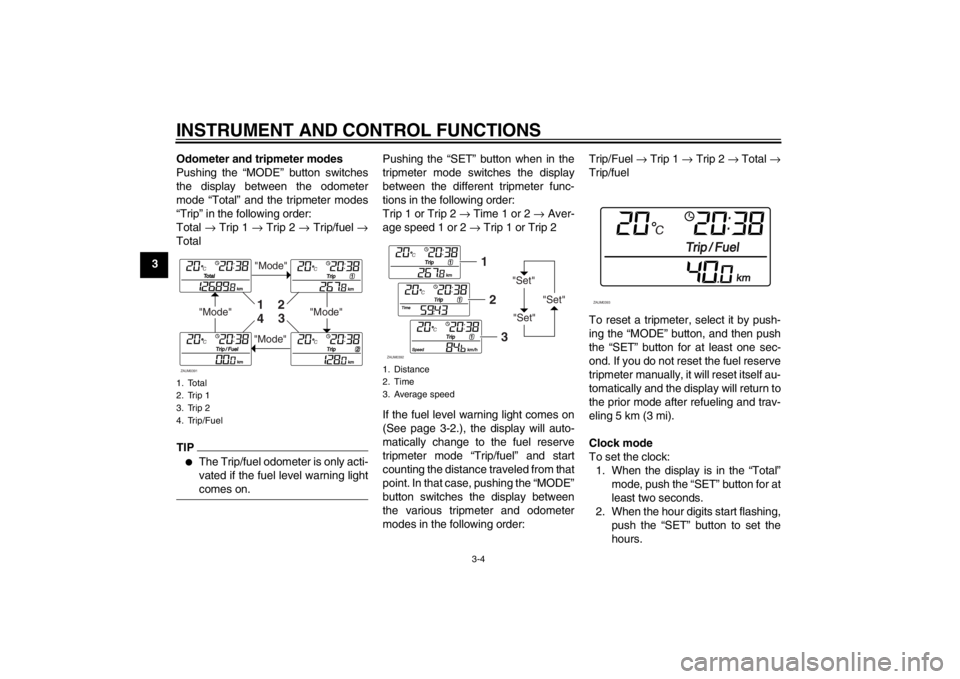
INSTRUMENT AND CONTROL FUNCTIONS
3-4
3Odometer and tripmeter modes
Pushing the “MODE” button switches
the display between the odometer
mode “Total” and the tripmeter modes
“Trip” in the following order:
Total → Trip 1 → Trip 2 → Trip/fuel →
Total
TIP●
The Trip/fuel odometer is only acti-
vated if the fuel level warning light
comes on.
Pushing the “SET” button when in the
tripmeter mode switches the display
between the different tripmeter func-
tions in the following order:
Trip 1 or Trip 2 → Time 1 or 2 → Aver-
age speed 1 or 2 → Trip 1 or Trip 2
If the fuel level warning light comes on
(See page 3-2.), the display will auto-
matically change to the fuel reserve
tripmeter mode “Trip/fuel” and start
counting the distance traveled from that
point. In that case, pushing the “MODE”
button switches the display between
the various tripmeter and odometer
modes in the following order:Trip/Fuel → Trip 1 → Trip 2 → Total →
Trip/fuel
To reset a tripmeter, select it by push-
ing the “MODE” button, and then push
the “SET” button for at least one sec-
ond. If you do not reset the fuel reserve
tripmeter manually, it will reset itself au-
tomatically and the display will return to
the prior mode after refueling and trav-
eling 5 km (3 mi).
Clock mode
To set the clock:
1. When the display is in the “Total”
mode, push the “SET” button for at
least two seconds.
2. When the hour digits start flashing,
push the “SET” button to set the
hours.
1. Total
2. Trip 1
3. Trip 2
4. Trip/Fuel
"Mode"
"Mode"
"Mode"
"Mode"1
2
3
4
ZAUM0391
1. Distance
2. Time
3. Average speed
"Set"
"Set""Set"
12
3
ZAUM0392
ZAUM0393
U5B2E4E0.book Page 4 Friday, June 1, 2012 9:06 AM